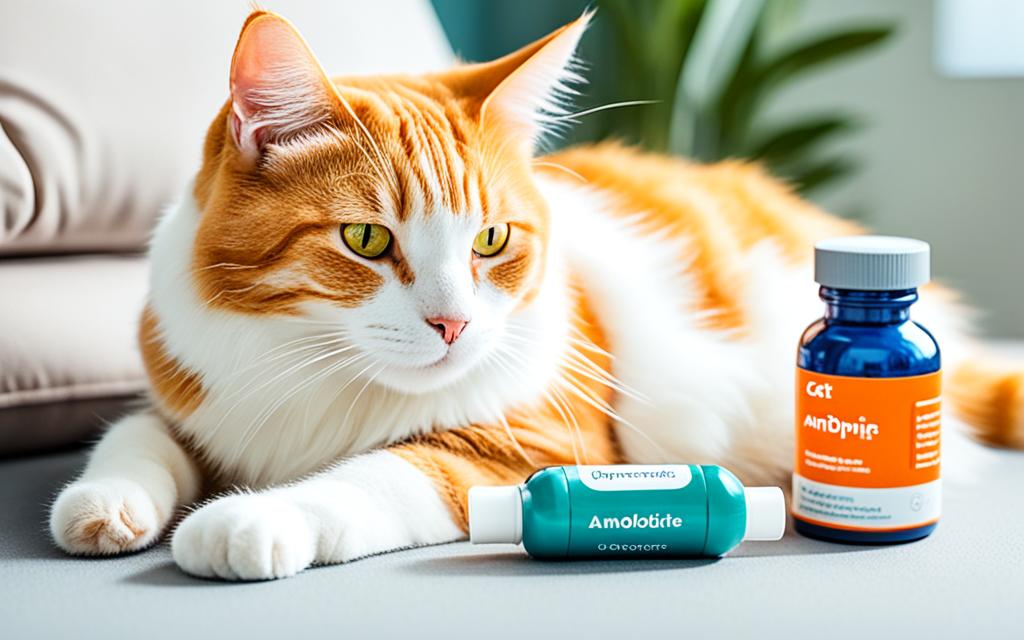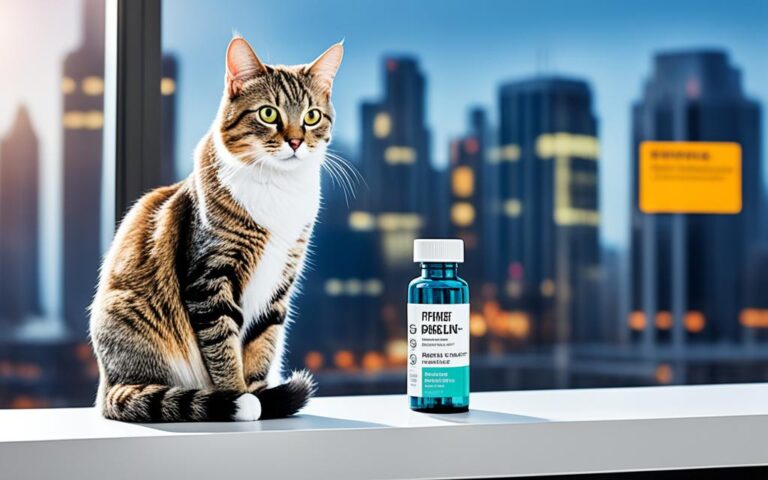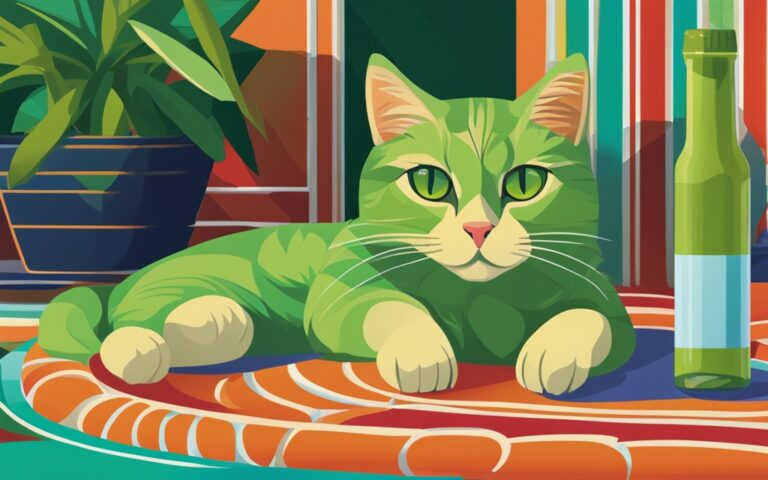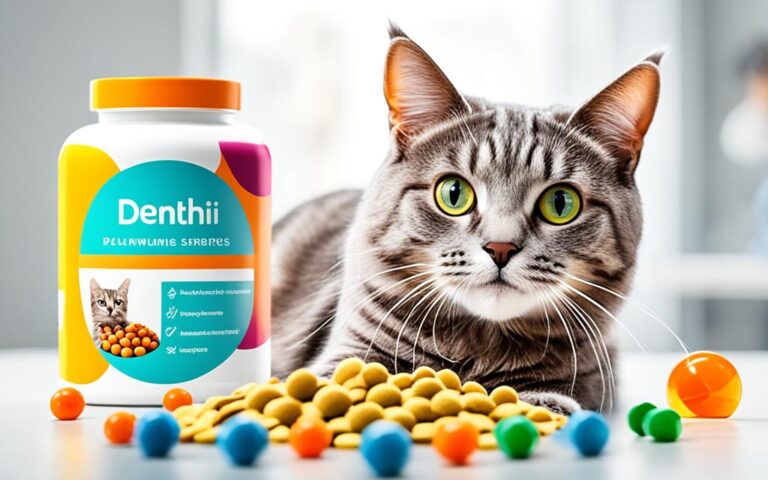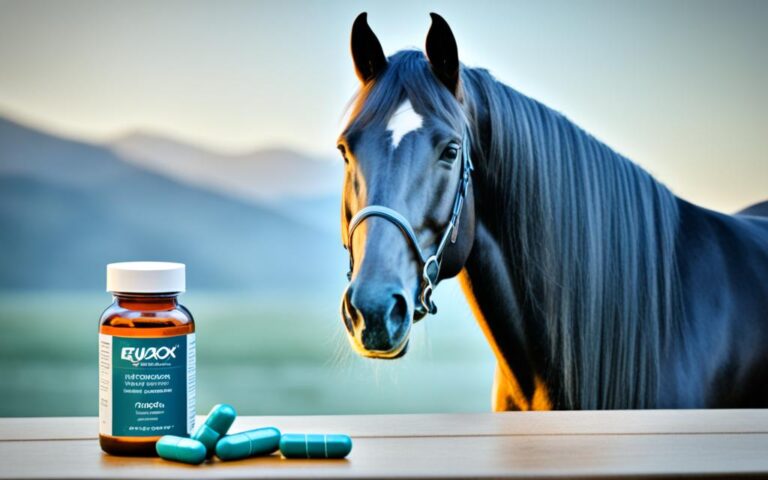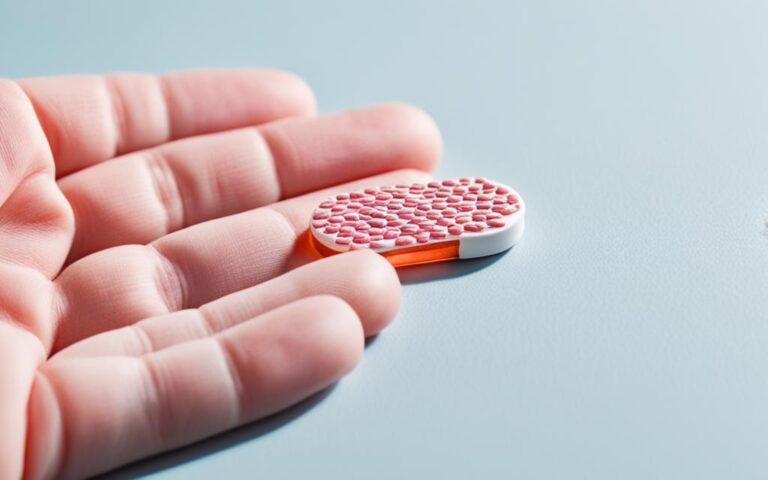Amlodipine Besylate for cats: Uses, Side Effects & Dosage
Did you know that Amlodipine (brand names: Norvasc®, Amodip®, Copalia®, Katerzia®) helps cats with high blood pressure1? This medicine is crucial for vets fighting hypertension in cats. It stops serious harm to their kidneys, eyes, and brain. Yet, it is not strictly approved for use in cats and dogs. So, always obey your vet’s advice.
Amlodipine Besylate comes in tablets or liquid, to be taken by mouth. It works in about 1-2 hours. Cats might vomit, feel sick, lose their appetite, or get tired. In rare cases, they could have dangerous heart rate changes, even collapse, weak legs, or bleed oddly1.
- It’s a go-to for lowering high blood pressure in cats.
- It kicks in fast, usually within 1-2 hours.
- Side effects vary from mild to some dangerous issues.
- Close vet checking is a must when giving this to cats.
- If a dose is missed, give it soon to keep their blood pressure steady.
Table of Contents
What is Amlodipine Besylate?
Amlodipine besylate is a type of drug that falls under calcium channel blockers. It is often given to cats and dogs to lower their high blood pressure. This medicine helps blood vessels relax and improves blood flow by stopping too much calcium from entering their muscle cells2.
Understanding the Drug and Its Purpose
It’s known for mainly working on the muscles of blood vessels. Because of this, it effectively lowers blood pressure with few side effects in cats. This makes it a go-to medicine for hypertension in our furry friends32.
Mechanism of Action
The drug stops calcium from entering specific muscle cells in the blood vessels. This action causes the vessels to relax, improving blood flow. As a result, blood pressure goes down. Its specific action on blood vessels is why it’s so good at treating hypertension in pets2.
Amlodipine besylate comes in three strengths: 2.5 mg, 5 mg, and 10 mg3. It’s the top choice for helping cats with high blood pressure. So, it plays a vital role in treating this common health issue in cats324.
Uses of Amlodipine Besylate for Cats
Amlodipine Besylate is a key medicine for cats. It’s used to fight high blood pressure. This is often seen in cats with kidney problems, an overactive thyroid, or heart issues567.
Treating Hypertension in Cats
Amlodipine Besylate helps a lot with high blood pressure in cats. High blood pressure can be really dangerous. It can hurt their eyes, brain, and other important organs7.
Studies show Amlodipine Besylate can lower a cat’s blood pressure by 28mm Hg in 28 days6. This can save their vision and protect their organs7.
Managing Kidney Disease and Thyroid Conditions
It’s not just for high blood pressure. Amlodipine Besylate also helps with kidney disease and thyroid problems. It makes a big difference by reducing protein in the urine of 69% of cats with kidney issues. This is an important sign of getting better5.
This medicine can also be used with others like ACE inhibitors to take care of high blood pressure. So, cats with a few health problems can get the help they need6.
| Condition | Amlodipine Besylate Dosage | Potential Side Effects |
|---|---|---|
| Hypertension in Cats | 0.625mg (1/4 of a 2.5mg tablet) once daily5 | Drowsiness, loss of appetite, weight loss, swelling of the gums, rapid heart rate5 |
| Hypertension in Dogs | 0.025 to 0.05 mg/lb once daily5 | Extended blood clotting time, other possible side effects5 |
Vets use Amlodipine Besylate for lots of health issues in cats. It helps control high blood pressure, supports kidney and thyroid problems, and more567.
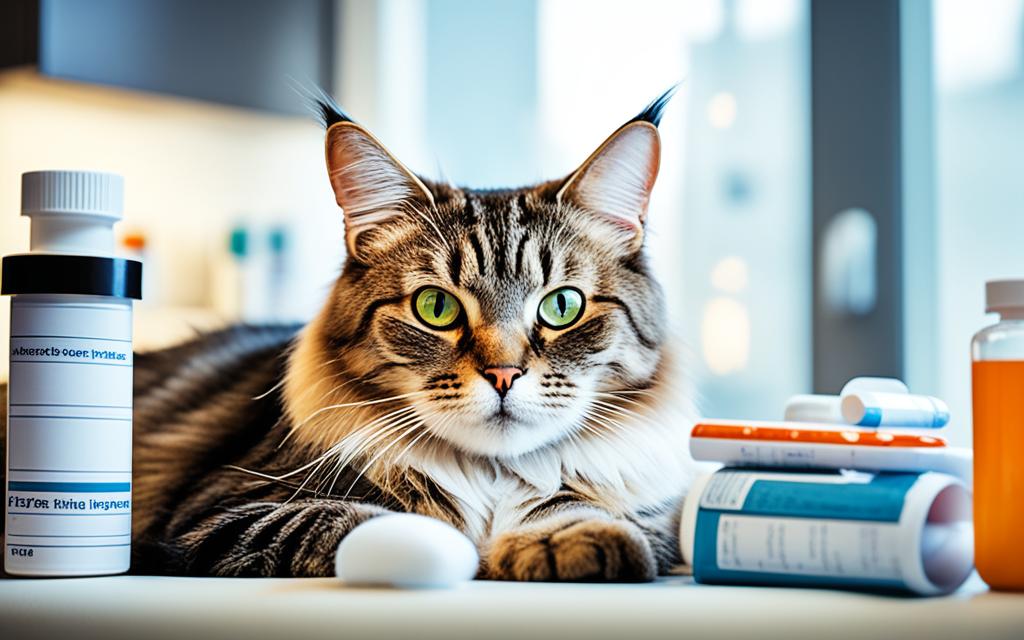
Giving Amlodipine Besylate the right way is really important. If a dose is missed, a cat’s blood pressure could go up quickly. This might be very bad for their health7.
By listening to the vet and following the right dose, cat owners help their pets stay healthy with this medicine.
Administering Amlodipine Besylate to Cats
Dosage and Frequency
When given by mouth, amlodipine besylate works well in cats. However, its effects start slowly and absorb fully over hours8. Vets usually recommend it once a day for cats9. Also, food doesn’t change how well a cat’s body takes in this medicine.
For cats with high blood pressure, the right amount is 0.125 to 0.5 mg per kilogram per day. But most cats start at a higher dose, between 0.625 and 1.25 mg9. Cats with very high blood pressure might need more medicine to lower it to less than 160 mm Hg8. If a cat’s blood pressure is over 200 mm Hg when first measured, they might start at 1.25 mg a day9.
Missed Dose Guidelines
If you forget to give a dose, do it as soon as you remember8. But if it’s almost time for the next dose, just wait. Giving two doses together is not safe for the cat8.
Always watch your cat closely when they’re taking amlodipine besylate. Higher doses can raise the drug’s levels in their blood8. We still need more studies to fully understand how this drug treats high blood pressure in cats8.
“Cats with systemic hypertension should be monitored at least every three months after stabilization.”9
Amlodipine Besylate for cats: Potential Side Effects
While Amlodipine Besylate is usually safe for cats, there are some side effects to watch out for10. Cats may eat less, have low blood pressure, or see their gums grow too much11. Keep an eye on your cat for any unusual changes in behavior or health while they are on this medicine.
Sometimes, cats might face more serious problems, like sudden diarrhea or swelling of the face10. Allergic signs could include itching, vomiting, hives, and shocked or comatose states. Such reactions need a vet’s help right away, as they could be deadly without prompt treatment.
It’s good for cat owners to know that Amlodipine Besylate might not mix well with other drugs that affect the liver, blood pressure, or heart10. Telling your vet about all medications your cat takes is crucial to avoiding bad interactions.
Though not very common, cats can still get side effects from Amlodipine Besylate. Staying alert and working with your vet closely can help keep your cat safe11. Be diligent in watching your cat’s response to the medicine and report any worrying signs quickly. This way, you can ensure their treatment is both successful and safe.
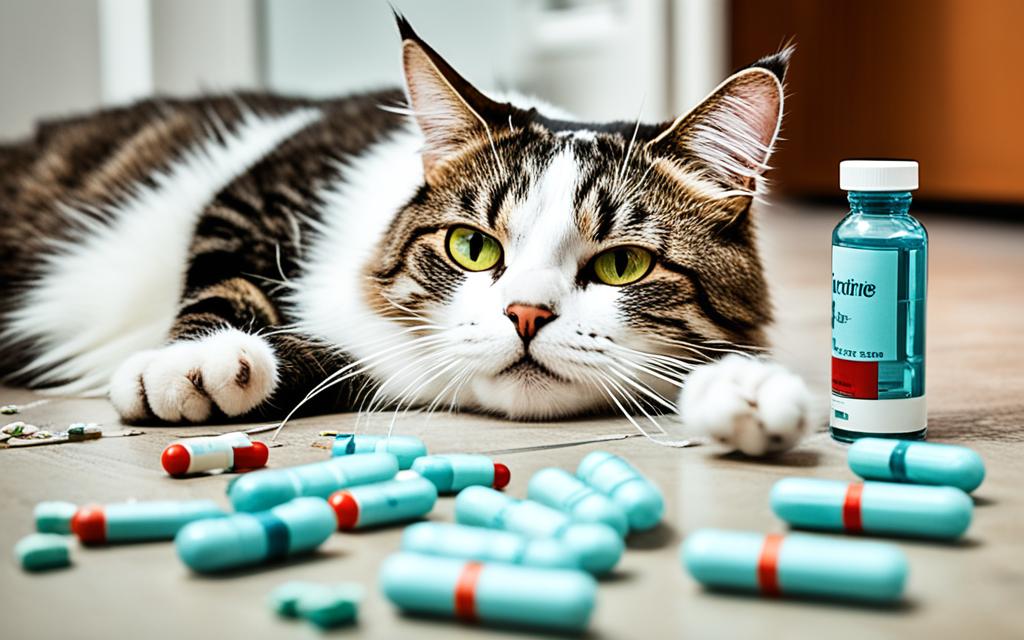
If you’re worried or have questions about using Amlodipine Besylate for your cat, talk to your vet right away111012. They’re there to give you advice that fits your cat’s needs.
Precautions and Drug Interactions
Using Amlodipine Besylate for cats with high blood pressure is common. But, we need to be careful about some things13. Don’t give it to pets with liver problems, since it might make things worse13. Also, avoid it for pregnant or nursing pets. We’re not sure what it might do to their babies13.
Pregnancy and Lactation Considerations
If a cat is expecting or nursing, giving Amlodipine Besylate should be a well-thought-out decision. We’re not entirely sure of the risks to their babies13. It’s best to look for other treatments or take extra care13.
Concomitant Medication Interactions
Using Amlodipine Besylate together with some other medicines might cause blood pressure to drop too low13. So, be careful with drugs like diuretics, beta-blockers, and vasodilators when using them with this medicine13.
Also, drinking grapefruit juice can change how this medicine works. But, it’s not a big concern for pets13. When mixing Amlodipine Besylate with other drugs, careful watching and maybe changing the doses is important.
| Medication | Interaction with Amlodipine Besylate |
|---|---|
| Diuretics | Increased risk of hypotension |
| Beta-blockers | Increased risk of hypotension |
| Vasodilators | Increased risk of hypotension |
| Grapefruit juice | Altered bioavailability |
With heart problems, using Amlodipine Besylate might not be the best idea. If they have heart failure or cardiac shock, it could make things worse13.
Veterinarians who know about these interactions and precautions can use Amlodipine Besylate safely. This helps make sure the cats get all the good without the bad131415.
Benefits of Amlodipine Besylate for Feline Hypertension
Amlodipine Besylate is a top choice for treating high blood pressure in cats16. This medicine helps by letting the blood vessels relax and improving how blood flows16. It lowers the blood pressure in cats. This means their heart and organs can stay healthy.
In a study, 100 older cats with high blood pressure got Amlodipine every day16. They started with a small dose and could get more if needed. The cats with the highest blood pressure needed the most medicine16.
Amlodipine also helps with a kidney problem called proteinuria in 69% of cats16. This is important because high blood pressure can make kidney disease worse.
Still, Amlodipine may not work for every cat with high blood pressure17. For some, we don’t know what causes the high blood pressure17. In these cases, using Amlodipine along with other medicines could be the best option17.
Amlodipine is a key treatment for high blood pressure in cats. It does a lot of good, like keeping their organs healthy. It’s an important choice for your cat’s health with your vet’s advice.
Comparing Amlodipine Besylate with Other Hypertension Medications
In treating feline hypertension, amlodipine besylate stands out as a top choice. It shows better results, is cost-friendly, and causes fewer side effects. This makes it a favorite among many vets.
Efficacy, Cost, and Side Effect Profiles
Studies confirm amlodipine’s strength in controlling hypertension in cats. For instance, 50 high blood pressure cats needed only a small dose of 0.625 mg to lower their blood pressure effectively.
Amlodipine is a budget-friendly option. Its once-a-day dose is not just convenient but also saves cat owners money18.
In terms of side effects, amlodipine is often well-received by cats. For example, only 7.3% of people taking amlodipine besylate report headaches as a side effect. Additionally, gingival hyperplasia occurred in only 8.5% of dogs on amlodipine besylate18. These numbers are lower than for many other drugs.
“Amlodipine is considered a very successful first-line treatment for systemic hypertension in cats, with a good efficacy profile and relatively rare side effects compared to other hypertension medications.”
With its strong effectiveness, affordability, and mild side effect record, amlodipine besylate is a winning choice for vets.
Storing Amlodipine Besylate Correctly
Keeping Amlodipine Besylate stored right is key for your cat’s health. Store the tablets in a place that stays between 68-77°F (20-25°C). It’s okay for the temperature to briefly go from 59-86°F (15-30°C)19. Make sure it stays dry and away from direct light to keep it strong and effective20.
For liquid Amlodipine Besylate, do what the compounding pharmacy says. It usually means keeping it at room temperature and using it within 90 days19.
Don’t forget, if you take tablets out of the pack, use them within a day. Keeping them wet or exposed to light for too long makes them less effective and safe19.
| Amlodipine Besylate Formulation | Recommended Storage Conditions | Shelf-life |
|---|---|---|
| Tablets | Controlled room temperature (68-77°F/20-25°C) | Blister pack: 24 hours after opening Bottle: No expiration date on label |
| Compounded Liquid Suspension | Room temperature, protect from light | 90 days |
| Compounded Transdermal Gel | Room temperature, protect from light | 20 days |
Follow these steps to keep your cat’s Amlodipine Besylate strong and working. This is how you take the best care of your cat1920.
Good storage is just one part of giving Amlodipine Besylate the right way. Always talk to your vet for advice on making sure it helps your cat and is safe2021.
Monitoring and Veterinary Follow-up
Taking care of your cat’s Amlodipine Besylate treatment is key to their health. Regular visits to the vet are a must. The vet will watch your cat’s blood pressure to ensure the medicine is working right. They can also adjust the dose if needed22.
Eye checkups and keeping an eye on potassium levels are also important. Be sure to follow the vet’s instructions for the full treatment plan. This is essential for your cat’s well-being22.
Regular Checkups and Adjustments
Your vet may suggest checking your cat’s blood pressure every 2-4 weeks at first. This helps see how your cat is responding to the Amlodipine Besylate. Adjusting the dose promptly keeps your cat’s blood pressure in check22.
- Monitoring blood pressure is crucial. Shockingly, just 1.34% of cats get regular checks22.
- Cats whose conditions were caught early survived longer than those noticed later22.
- Regularly adjusting the Amlodipine Besylate dose helps improve survival outcomes22.
By keeping up with vet visits and dose tweaks, you’re giving your cat the best shot at health22.
“Cats diagnosed due to monitoring of pre-existing disease showed improved survival compared to those diagnosed after clinical signs were recognized.”
It’s not unusual for older cats, especially if they have other health issues, to develop high blood pressure. Up to 13% of healthy older cats can face this problem. For those already dealing with other diseases, the chance goes up to 87%. This makes it even more crucial to keep an eye on their blood pressure and manage it carefully23. Monitoring and managing their condition is essential for their health and happiness22.
Staying in touch with your vet and keeping up with monitoring and adjustments is a big deal. It is vital for managing your cat’s high blood pressure well. This improves their quality of life222423.
Handling Emergencies and Overdose Situations
Amlodipine Besylate helps treat high blood pressure in cats and dogs. Yet, it’s important to know about the risks of emergencies or overdosing1. Too much amlodipine can threaten life. Signs include very low blood pressure, fast or slow heart rate, odd heart rhythm, extreme tiredness, high blood sugar, muscle shakes, or seizures1. If you think there’s been an overdose, contact your vet at once. Or, rush to an emergency vet. You can also reach out to a poison control center for animals.
Overdosing on substances like amlodipine, which is a calcium channel blocker, is well-documented25. The American Association of Poison Control Centers stated 927-1057 cases in 2007. These numbers show how serious this issue is25. Unfortunately, 2021 had 1381-1643 similar cases, which means it’s becoming more common25.
Children under 6 are at high risk with amlodipine25. A particular study covered 186-93 cases of kids under 6 dealing with this drug, pointing to the need for safe storage25. Also, a different study found that 581-586 kids who took calcium channel blockers needed care. This stresses the need for secure packaging25.
If there’s an amlodipine emergency, acting fast is crucial1. Quick steps like calling your vet or poison control could save a life1. Knowing about drug interactions is vital too. A study showed around 157-158 cases where mixing some drugs was life-threatening25.
Dealing with overdoses and emergencies is hard. But, there are ways to help lower the risks25. Glucagon has been successful in some cases of too much amlodipine25. Also, high blood sugar was found in over 2000 cases with some drugs. So, it’s important to watch sugar levels25.
Knowing the risks and how to react in an amlodipine emergency is key for pet owners and vets. Being prepared and informed can safeguard our pets1.
Conclusion
Amlodipine Besylate is a strong calcium channel blocker for cat hypertension26. This type of high blood pressure is common in older cats and can lead to health problems27. Medications like Amlodipine, like Amodip 1.25 mg Chewable Tablets for Cats28, help manage blood pressure and protect organs from harm.
Hypertension in cats doesn’t always have a clear cause26. But, Amlodipine Besylate, sometimes with other drugs, can control it26. Regular visits to the vet are crucial. They help ensure the medicine works well for your cat.
Learning how Amlodipine Besylate works and its dosages can aid pet owners. It lets them partner with vets in caring for cats’ hypertension. Amlodipine is a key medicine in fighting cat heart diseases. It brings a chance for better life and health for feline friends.
FAQ
What is Amlodipine Besylate?
What are the primary uses of Amlodipine Besylate in cats?
How is Amlodipine Besylate administered to cats?
What are the potential side effects of Amlodipine Besylate in cats?
Are there any precautions or interactions to be aware of with Amlodipine Besylate?
What are the benefits of using Amlodipine Besylate to manage feline hypertension?
How should Amlodipine Besylate be stored and what monitoring is required?
What should I do in the event of an Amlodipine Besylate overdose?
Source Links
- Amlodipine | VCA Animal Hospitals
- Amlodipine Besylate (Norvasc®, Istin®) for Dogs and Cats
- AMLODIPINE BESYLATE – Mar Vista Animal Medical Center
- Amlodipine for Cats: Dosage, Safety & Side Effects – Cats.com
- Amlodipine 2.5 mg (sold per tablet) | 1800PetMeds
- Amlodipine | Hillcrest Veterinary Hospital
- Amlodipine Besylate Side Effects in Cats
- LC-MS in vetinary medicine sheds light on treatment for hypertension in cats
- Latest Tips for Management of Feline Hypertension – WSAVA 2018 Congress
- Amlodipine Besylate (Generic)
- Amlodipine (as Besylate) Mini Tabs | Northwest Compounders
- Amlodipine for Dogs and Cats
- Amlodipine Besylate | Wag!
- Amlodipine in Vet Medicine – Facts and Information | PetCoach
- Journal Scan: New insights on treating hypertension in cats
- Journal of Veterinary Clinics
- Amlodipine Besylate (Norvasc)
- Amlodipine Besylate (Compounded)
- Pet Factsheets – Crossriggs Veterinary Clinic
- Calcium Channel Blockers
- Survival after diagnosis of hypertension in cats attending primary care practice in the United Kingdom
- Layout 1
- Amlodipine
- Approach Considerations, Prehospital Management, Emergency Department Management
- Feline Hypertension: Risks and Management – WSAVA2005
- Blood pressure: A critical factor (Proceedings)

